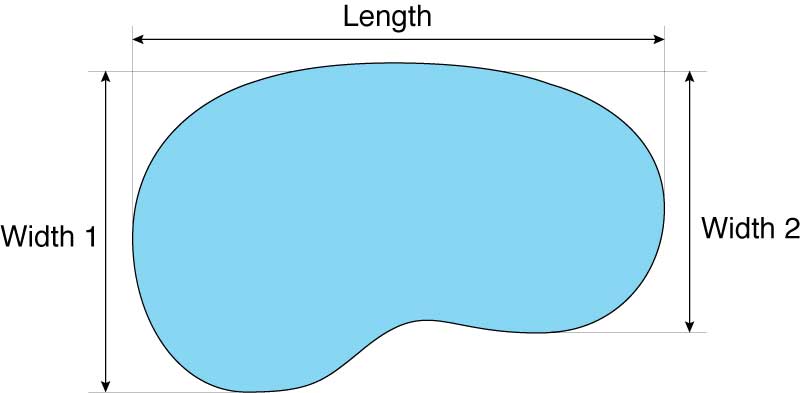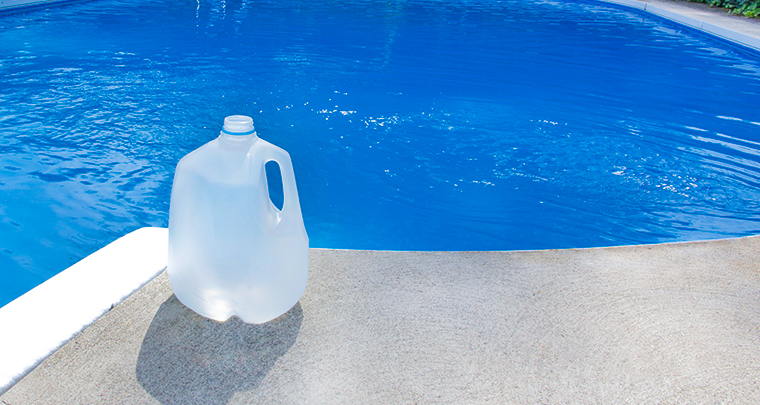
For precise calculations, it is recommended that pool be divided into various areas according to the depth. Add the volumes together to determine the total capacity.Including the depth of the pool with the surface area will determine the cubic volume. Take the measurements of these areas and refer to the above calculation to find the area of each square, rectangle, or circle. In order to find the capacity of irregular shape d pools, imagine the hot tub or pool as a grouping of smaller, regular shapes. Therefore, you might want to treat it as two separate volumes-the volume above the seat line and the volume below. In measuring the capacity of a spa, you might need to calculate two or three sections within the hot tub and add them together to arrive at a total volume due to the seats. Π x radius squared x average depth = volume With this information, you can return to the formula:

Now to find the radius squared, multiply 1.5 m by itself to arrive at 2.25 m 2. Squared means the number is multiplied by itself, so multiply the radius by itself.įor example, if the diameter is 3 m, we can half this value for a radius of 1.5 m. The radius is half of the diameter, so measure the distance across the widest part of the circle and divide it by 2 to find the radius. The number 3.14, refers to pi, which is a mathematical constant. The formula: π x radius squared x average depth = volume Calculating the accurate volume is crucial, as it could mean serious errors when adding chemicals, which are added based on the volume of water. Make sure to use the actual water depth in your calculations, not the depth of the container. Calculate the volume of the shallow portion and add that to the volume you calculate for the deeper portion. Measure the length, width, and average depth of the shallow section, then take the same measurements for the deeper section. In such a case, you might want to treat the pool as two parts. If the majority the pool is shallow and then drops off suddenly t o a deep end, you will have a different average depth. Average depth = (Depth at the shallow end + Depth at the deep end) / 2.If the shallow end is 0.5 m and the deep end is 1 m, and assuming the slope of the pool bottom is gradual and even, then the average depth is 0.75 m Measure the length, width, and average depth of the pool, rounding each measurement off to the nearest meter. If you’d like to find the pool volume in gallons, multiply your results by 7.5, as there are 7.5 gallons for each cubic foot. Multiplying that by the average depth gives the volume in cubic meters. Length times width gives the surface area of the pool. Length x width x average depth x 7.5 = volume (in gallons) Variable Depth Pools: Square and Rectangular Multiplying that by the depth gives the volume in cubic meters.


Length x width x depth x 7.5 = volume (in gallons)

Length x width x average depth = volume (in meters cubed) Constant Depth Pools: Square or Rectangular For accurate calculations, the pool should be divided into various areas according to the depth. Area of a right triangle: A = (L x W)/2Ĭ alculated the cubic volume by including the surface area and depth of the pool.Area of a square or rectangle: A = L x W.Following are the basic formulas and calculations to determine surface areas: We can use a few simple formulas to calculate pool size. Calculating a pool's area in square meters or feet is the first step in determining information including meters cubed or gallons, maximum capacity of swimmers and other critical information about your pool. Calculating the capacity a pool or spa requires the volume and surface area of the pool or spa.


 0 kommentar(er)
0 kommentar(er)
